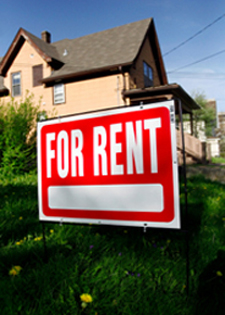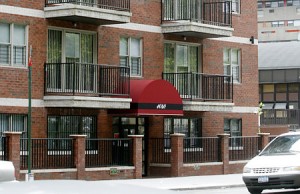Posted by Teresa on November 9, 2009 under Housing Trends | 
 Coldwell Banker, the nationwide real estate firm, released a report on the most affordable college towns for investors. From Syracuse, NY, home of the University of Syracuse, to Athens, GA, where the UGA Bulldogs play, to the University of Notre Dame’s South Bend, IN, the comparison was limited to big football schools and homes of 2,200 square feet, four bedrooms, and two and a half baths. 120 markets were surveyed.
Coldwell Banker, the nationwide real estate firm, released a report on the most affordable college towns for investors. From Syracuse, NY, home of the University of Syracuse, to Athens, GA, where the UGA Bulldogs play, to the University of Notre Dame’s South Bend, IN, the comparison was limited to big football schools and homes of 2,200 square feet, four bedrooms, and two and a half baths. 120 markets were surveyed.
The results show that in 62% of the markets surveyed, real estate investors can pay less than $250,000 for homes of this size. Clearly, college towns offer great affordability for rental homes. Plus, the culture and ambiance of a college town makes these markets even more appealing to renters.
Some interesting facts that the study highlighted:
• The PAC-10 is the most expensive real estate conference, with an average of $747,180 for 4BR/2.5B/2200 SQ FT homes.
• Most affordable is the Mid America conference, where the average comparable home costs just $182,222.
• The ten most expensive college markets have average home prices ranging from $568,317 in Seattle, WA (University of Washington) to $1,489,726 in Palo Alto, CA (Stanford University).
• If those prices are too rich for your investing pocketbook, look to the middle portion of the US, where the ten least expensive college towns in this survey lie: Akron OH, Muncie, IN, Ann Arbor, MI, Ypsilanti, MI, Fort Worth, TX, Tulsa OK, Denton, TX, Houston, TX, Bloomington, IN, and Kent OH. Average prices for the four-bedroom comparison home in these markets are in the $122,000 — $166,000 range.
The president of Coldwell Banker called college markets a “best-kept secret” of the real estate industry. And, real estate pros have been investing in them for years. If you’re looking for your next investment opportunity, a rental home in a football-friendly college town just might be it!
Posted by Teresa on November 5, 2009 under Housing Trends | 
 Where are all the tenants? Some are moving back home with mom and dad. Or returning to school and living with relatives. Others took in roommates to help pay the rent, or are staying with friends temporarily.
Where are all the tenants? Some are moving back home with mom and dad. Or returning to school and living with relatives. Others took in roommates to help pay the rent, or are staying with friends temporarily.
These are some of the reasons tenants are out of the rental market, causing the U.S. apartment vacancy rate to rise to 7.8% in the 3rd quarter. This 23-year high occurred despite landlords nationwide lowering rents. Reis, Inc., a real estate research firm that published the vacancy report, stated that the peak has not yet been reached; they expect the number to climb above 8% in the coming months.
Nervous landlords are looking toward the traditionally slow 4th quarter with little hope for improvement, which is expected sometime in 2010—perhaps as soon as the second quarter.
While vacancies increased, rents have declined for four quarters in a row—which may have kept the vacancy rate from soaring even higher. Landlords have responded quickly to market conditions, including over supply, and lowered rents to keep tenants. Rents are expected to stay soft for at least another year.
Oversupply will continue to be a contributing factor to the vacancy problem. 73,000 apartment units have come on the market in the first three quarters of 2009, and 42% of them remain vacant, according to Reis. The bright spot is that new apartment construction has slowed down to a trickle, so eventually, demand will catch up to supply.
As unemployment hovers near 10% nationwide, and benefits start running out, rent money is disappearing, too. Simply put, folks with no rent money cannot be tenants. Landlords will need to continue aggressively seeking out new tenants to fill vacancies, offer incentives to good tenants to get them to stay, and hold on until the job market improves—when there are more people with money to spend on housing.
Especially in a down economy, we recommend you
screen all tenants as part of your application process. For more landlord resources, including forms and information on
tenant screening, turn to
E-Renter.com. .
Posted by Teresa on August 4, 2009 under Housing Trends, Tenant Credit Checks, Tenant Screening & Background Checks | 
 As the housing market struggles to recover from its historic downturn, thousands of new condominiums remain unsold across the country. Many cash-strapped developers are turning to leasing unsold units—which can cause problems among residents who purchased theirs.
As the housing market struggles to recover from its historic downturn, thousands of new condominiums remain unsold across the country. Many cash-strapped developers are turning to leasing unsold units—which can cause problems among residents who purchased theirs.
Condos are usually rented by their owners—not by the developers of a project. But when the majority of units have not sold, developers—and their lenders—get more creative. Renting is one way to fill units and improve cash flow. And in this economy, cash is king!
But is renting to unknown tenants okay with the owners in the building? Often, it depends on numbers. A few rented units, while a risk for the developer because they can no longer be sold as “new,” are usually not a problem with the owner-neighbors. But when a majority of units are rentals, it can hurt property values—and discourage potential buyers, too. Renting condo units can become a sure way to prevent selling units—an unending cycle.
However, even if condo owners don’t like buildings inhabited by renters, there is usually little they can do about it. Most developers will reserve the right to lease unsold units in the sales contract—and buyers have already agreed to it.
If you’re a developer with unsold condo inventory on your hands, you might consider renting units to quality, pre screened tenants. You can appease unit owners by assuring them the condos will be rented only to tenants who have passed background checks, including credit checks and criminal history screening. You’ll sleep better, too, when you properly screen tenant applicants!
Besides, condo owners might consider themselves lucky to not own a unit in a certain luxury building in New York City—where the owner is renting unsold units to a homeless shelter. Sometimes you do what you have to do—and at least the homeless are benefiting.
Posted by Teresa on April 16, 2009 under General, Housing Trends | 

The apartment vacancy rate for the top 79 US markets reached an average 7.2% in the first quarter of 2009, according to Reis Inc., a New York research firm. This is a full percentage point increase from the previous two quarters. Reis predicts rents down as much as 2% for the year, and apartment vacancy rates above 8%.
Increased perks, like lower or free rents, have not helped the situation. In the past, these concessions by property managers led to lower vacancies—but not now. Part of the problem is an oversupply, as unsold condominiums are converted to rental properties. Plus, continued rising unemployment, coupled with the downturn in housing markets, are not bringing former homeowners back as renters. Many are renting their homes, and are now property managers themselves.
Where are all these foreclosed homeowners living? Good question. It’s possible there are more folks living with family or friends. In addition, cash-strapped homeowners are renting rooms to boarders. Packing existing housing with more bodies seems to be the nationwide trend.
In LA County, 41,000 people moved out of an apartment in 2008, while only 29,000 moved in during the last five years. But not all areas are being affected equally. Well-run properties in real estate markets where people want to live are holding steady, while areas of overbuilding are hurting.
Other areas with big increases in vacancy rates in Q1 2009 include Austin, TX, from 7.5% to 9.2%; Fairfield County, CT, from 4.3% to 6%, and Knoxville, TN, from 5.3% to 7%. [Source: the Wall Street Journal.]
It looks like for the remainder of 2009, renters will find more choices within their budgets, while many landlords will be forced to continue cutting rents in an effort to attract new tenants or keep the ones they have. Well-positioned rental property investors could take advantage of unprecedented buying opportunities in certain markets.
For more landlord resources, including everything you need to know about
tenant screening, turn to
E-Renter.com. You’ll know that you have the best possible tenants when you
prescreen.
Posted by Teresa on March 31, 2009 under Housing Trends, Landlord Tips, Tenant Credit Checks | 

Falling Prices no Cause for Panic
The heated rental market of the past few years is definitely over. Rent increases followed housing price increases to unsustainable levels. Reports from around the country show that rents continue to fall.
In New York City, the biggest drop, 8% over last year, was in the category of studio apartments in doorman buildings. In a city like New York, where rents are excessively high when compared to the rest of the country, that’s significant. Renters in NYC are used to numbers like $3,395 for one-bedroom apartments with a doorman (but you can lose the doorman and pay only $2,632). It’s a tough, competitive market—but people are finding more rental deals than ever right now.
Renters who signed leases at the height of the bubble are more interested in investigating their alternatives—including moving—than before. Most folks are not willing to pay more, but they are looking for—and finding—similar properties for less money.
Other renters are downgrading to cheaper properties just to save money. With job security at a new low for many working people, the opportunity to save several hundred dollars a month only makes sense. Thrift is in, and the ability to sock away money in savings appeals to people who never considered it before.
What could this mean to landlords and property managers? Expect to work a little harder to secure and keep good tenants. It’s a renter’s market, but there are still good, solid tenants looking for rental properties. Make sure your property is in top condition and advertise it well.
In this market, current tenants might ask for rent reductions at lease renewal time. To avoid reducing the rent, think creatively of other ways to keep them. Perhaps you can pay for certain utilities, or upgrade the cable package. If you have a vacancy elsewhere, upgrade a good tenant to a nicer property. A fresh coat of paint or new carpet could be perks a tenant would stay for.
Some landlords, desperate to keep properties filled, are accepting tenants with bad credit. This “I’ll take anyone” approach is a mistake. Tenants with bad credit could cost you much more money over time than you’ll lose by waiting for a solid tenant. And in this economy, a low credit score is likely to get worse, not better. There is no better time to thoroughly check your prospective tenants’ backgrounds and credit histories.
The rental market will swing back up again. Rents are often tied to jobs, and when job numbers increase again, look for signs that rents are on the increase. Until then, be patient, don’t panic, and plan carefully. Consider new ways to keep your properties leased; be open minded to new ideas and to all requests from your tenants. But remember, you are under no obligation to let tenants out of a binding lease, just because they can rent somewhere else for less.
For more landlord resources, including everything you need to know about
tenant screening, turn to
E-Renter.com. You’ll know that you have the best possible tenants when you
prescreen.
 Coldwell Banker, the nationwide real estate firm, released a report on the most affordable college towns for investors. From Syracuse, NY, home of the University of Syracuse, to Athens, GA, where the UGA Bulldogs play, to the University of Notre Dame’s South Bend, IN, the comparison was limited to big football schools and homes of 2,200 square feet, four bedrooms, and two and a half baths. 120 markets were surveyed.
Coldwell Banker, the nationwide real estate firm, released a report on the most affordable college towns for investors. From Syracuse, NY, home of the University of Syracuse, to Athens, GA, where the UGA Bulldogs play, to the University of Notre Dame’s South Bend, IN, the comparison was limited to big football schools and homes of 2,200 square feet, four bedrooms, and two and a half baths. 120 markets were surveyed.



